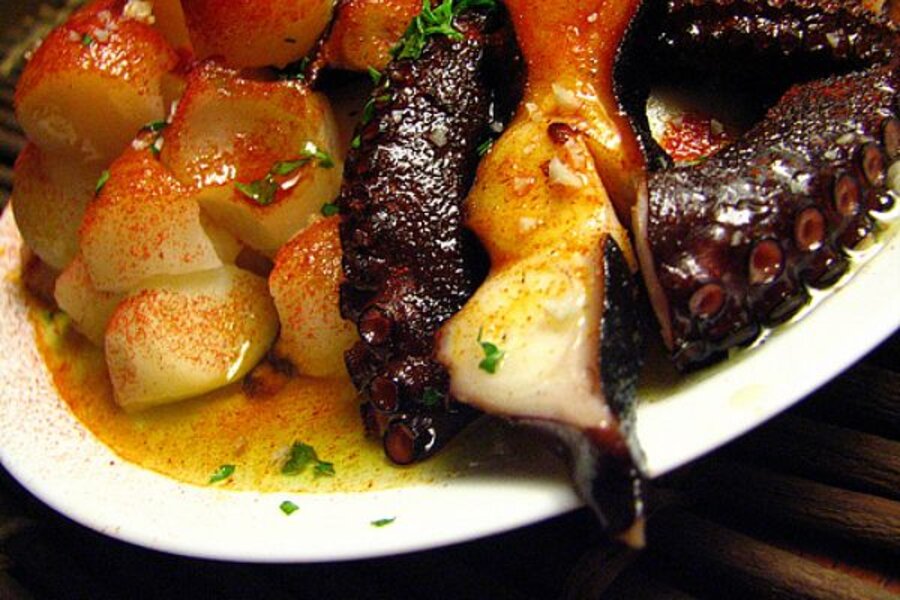Tapas recipe: Galician-style octopus
The first time I ate pulpo a la gallega was at a very disreputable-looking food stand not far from the Estadio Balaídos in Vigo, Spain, before watching a soccer match between Celta de Vigo and Racing Santander (it finished 2-2). It was served on a slightly wilted plastic plate with a toothpick that looked suspiciously blunt at one end, as if it had already been used.
The second time, things improved considerably, reclining, as we were, in some old oak chairs in a tapas bar in Madrid after a morning in El Museo del Prado. The only unpleasant feeling came from our sadness when the generous racione was finished. While pondering these feelings, Amy and I came to the conclusion that it’s one of the world’s greatest snack foods. Chewy, salty, sweet and filling, healthy and satisfying, pulpo a la gallega is simply chopped boiled octopus in the Galician style – dressed with sea salt, olive oil and sweet pimenton – and in Galician pulperias is commonly served on a wooden board with toothpicks. Like so many tapas, and Spanish dishes generally, it is achingly simple, and yet unbelievably good. Add anything to it and it becomes something else, take something away and it’s missing a key element.
That said, this, the signature dish of the region, is sometimes made with potatoes and when it is, is normally cooked on a hot plate and referred to as pulpo a la plancha. Another variation, pulpo a la feria, or pulpo a la feira in Gallego (the local dialect that sits somewhere between Spanish and Portuguese) is traditionally cooked in a copper kettle which gives the purple (when cooked) octopus a more orangey color and interesting minerally-taste. When such traditional vessels are unavailable (like virtually everywhere), a copper coin is often tossed in to the boiling water.
In an effort to do it all in one dish, as we only had one octopus – we boiled the 'pus with a copper coin and boiled some potatoes separately, then combined them on the plate with the salt, pimenton and olive oil. It was delicious. The texture of octopus might be off-putting for some, as it’s kind of chewy on the outside and “crunchy” on the inside, but I love it, and when cut into inch-long chunks it makes a fantastic finger-food, if your guests are adventurous enough to try it. Not only that, but it’s easy to prepare and octopus is pretty reasonably priced.
Pulpo a la Gallega
1 pre-frozen medium octopus – around 1lb., pre-cooked (if not pre-frozen, freeze it for 24 hours)
2 quarts (roughly, or 2 liters) water, boiling
1 bay leaf (optional)
1/2 onion (optional)
1/4 cup vinegar (optional)
2-3 ounces extra virgin olive oil
1 teaspoon pimenton dulce/sweet paprika
1/2 teaspoon coarse sea salt
2 medium waxy potatoes, peeled and balled (using a melon-baller)
Gently boil octopus in 2 quarts/2 liters salted water, remembering to add a copper penny, for 1 hour. (Some recipes call for bay leaf, onion, and vinegar, some not, in the water. Our experience tells us adding a 1/4 cup of white vinegar helps to tenderize the ‘pus a little.)
Allow to cool before slicing into 1-inch/2-cm chunks. Dress with olive oil, and sprinkle generously with pimenton and salt.
In a separate pot, boil potatoes in salted water until tender.
Serve with potatoes and lots of crusty bread.
Note: our friend CanaryGirl has also made Pulpo a la Gallega and her technique for boiling the octopus is rather different from ours. Check her out and feel free to tell us which you think worked best.
Jonny Seponara-Sills blogs with his wife, Amy, at We Are Never Full.
To comment on the original post, click here.
--------------------------------------------------------------
The Christian Science Monitor has assembled a diverse group of food bloggers. Our guest bloggers are not employed or directed by The Monitor and the views expressed are the bloggers' own and they are responsible for the content of their blogs and their recipes. All readers are free to make ingredient substitutions to satisfy their dietary preferences, including not using wine (or substituting cooking wine) when a recipe calls for it. To contact us about a blogger, click here.





